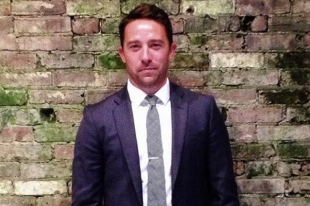‘Project-based learning and Common Core are a natural fit’

Tyler Graff
Tyler Graff is the incoming master at the Claire Lilienthal alternative school in San Francisco Unified.
Previously, he was principal of Stevenson Elementary, a public schoolhouse in Mountain View, where he kicked off a projection-based learning initiative in 2012.
In projection-based learning, students work on a complex problem or topic that often incorporates working equally a squad and involves a student presentation of work. At Graff's school, the program started equally a pilot and expanded each yr.
Graff earned his bachelor's degree and multiple subjects didactics credential from California State Academy, Chico. He earned his master's degree in schoolhouse leadership at the Harvard University Graduate School of Education.
In late June, EdSource asked Graff near what he learned working with teachers and students using this approach.
Why practise you use project-based learning at your public elementary school?
Non simply do student attitudes about learning meliorate as they engage in projection-based learning, students retain the data they're taught on a deeper level. When done well, it helps students with the soft skills of collaboration, communication, creativity, and disquisitional thinking that many colleges and employers are looking for. Students are able to comprehend, apply, and retain the content knowledge taught while developing the 21st Century Skills that the Mutual Core Standards ask of teachers and students.
Give an example of a project that worked well at your school. What made it succeed? How did yous know?
Our 2d- and tertiary-grade combination class took a deep look into local school board elections. During the project, students interviewed the candidates, researched the topics the board would exist voting on, wrote messages, created pamphlets, and registered voters. Information technology was clear that the project was successful from talking with the students. They were able to articulate their views on the issues and which candidates they would vote for and why. Students learned a lot about interviewing and writing in addition to social studies components linked to our local customs. The writing and cognition that was produced through the course of this project certainly met the curriculum standards, and our students became meaningfully engaged in their community.
How does project-based learning fit in with the priorities of Common Core?
Project-based learning and the Mutual Cadre are a natural fit. At our school, this was one of the core ways we started to address the new standards. What comes to mind start for me are close reading, application of knowledge, and disquisitional thinking. In project-based learning, students need to enquiry, read, have notes, and synthesize data, exactly what the Common Core asks students to do. In both cases, students need to recollect critically well-nigh and utilize knowledge from their learning. This happens in both language arts and mathematics.
What do schools and districts need to know before they start a project-based learning initiative and what's a good entry point for projects and preparation?
Done well, project-based learning requires an all-encompassing amount of professional person evolution, fourth dimension, and reflection. This is not an initiative that you can purchase to plow a school around; it'southward really a shift in the way content is presented. That takes time. In my experience, teachers tend to thrive with professional learning experiences that give the big picture beginning, and then drill downwards in the details of how each element of the project works. For case, a group of teachers interested in implementing project-based learning might do a multi-solar day training looking at the entire telescopic and sequence of a projection by experiencing i themselves. From there, they'd spend time learning well-nigh how to create a culture of critique in the classroom, how to successfully facilitate group piece of work, pupil presentations, and more than. Using a cycle of learning, implementing, and refining with each of these elements will lead to high-quality project-based learning.
What advice practice y'all have for schools just starting out?
As we all know, the number ane indicator of educatee success at the schoolhouse site is the quality of the teacher. With that said, it'southward important that you find the funding and time to allow teachers to learn, experiment, struggle, and refine their do.
I would circumspection any ambassador not to motion too quickly through this process. Deeper learning takes fourth dimension! This is truthful for students in the classroom and adult learners. At our simple school, nosotros decided to do a school-wide scroll out (fourteen classrooms) of one project per yr for the first three years. It wasn't until our third year that nosotros started doing Exhibition Nights. Depending on the staff culture, it might exist smart to have a class level or group of teachers pilot project-based learning for a year or two earlier moving to a whole scale approach. Ultimately, each school and commune is unlike. Taking the needs of your staff into account before creating a strategic programme will ensure project-based learning initiatives will take root and thrive.
If you accept any questions virtually how to implement project-based learning in your school or commune, please reach out to me at tyler.graff@gmail.com.
To get more reports similar this 1, click hither to sign up for EdSource's no-price daily email on latest developments in education.
Source: https://edsource.org/2015/project-based-learning-and-common-core-are-a-natural-fit/82676
0 Response to "‘Project-based learning and Common Core are a natural fit’"
Enviar um comentário